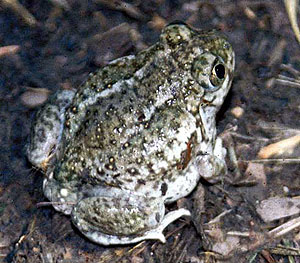![[sticky pads]](../pictures/stickygreen.jpg) Tree frogs, like this White-lipped Treefrog (Litoria infrafrenata), have sucker-like adhesive disks, or Sticky pads,
which aid in climbing, on the tips of the fingers and toes.
Tree frogs, like this White-lipped Treefrog (Litoria infrafrenata), have sucker-like adhesive disks, or Sticky pads,
which aid in climbing, on the tips of the fingers and toes. This image is from the Frogs of the Townsville Region page.
![[sticky pads]](../pictures/stickygreen.jpg) Tree frogs, like this White-lipped Treefrog (Litoria infrafrenata), have sucker-like adhesive disks, or Sticky pads,
which aid in climbing, on the tips of the fingers and toes.
Tree frogs, like this White-lipped Treefrog (Litoria infrafrenata), have sucker-like adhesive disks, or Sticky pads,
which aid in climbing, on the tips of the fingers and toes.
This image is from the Frogs of
the Townsville Region page.
Aquatic Frogs like the African Dwarf Frog in the Meet My Pets page, and the African Clawed Frog, have webbing between their toes that aid in swimming.
 You can test how much this helps by the following little experiment:
You can test how much this helps by the following little experiment:
This adds a lot of swimming power!
 Frogs that burrow into the sand to keep moist in the heat have stubby clawlike fingers that are adapted to digging.
Frogs that burrow into the sand to keep moist in the heat have stubby clawlike fingers that are adapted to digging.
One example is the Plains Spadefoot Toad as seen here.
(Photo courtesy of Jeff LeClere and the Iowa Herpetology website)
![[Flying Frog]](../pictures/flythm.gif) Some frogs in the Rhacophorus species, such as R. reinwardtii and R. nigropalmus,
have parachute-like webbing on their hands and feet which act as an air-brake when they glide
from tree to tree or leaf to leaf. These frogs are known as "Flying Frogs."
Some frogs in the Rhacophorus species, such as R. reinwardtii and R. nigropalmus,
have parachute-like webbing on their hands and feet which act as an air-brake when they glide
from tree to tree or leaf to leaf. These frogs are known as "Flying Frogs."
The image on the right is an old woodcarving of a Javan Flying Frog in descent. Click on it to see it enlarged.
Try this little experiment to see how webbing helps:
Without the extra webbing, a falling frog would go *SPLAT!*
Back to Strange but True Facts.
Back to FROGLAND.